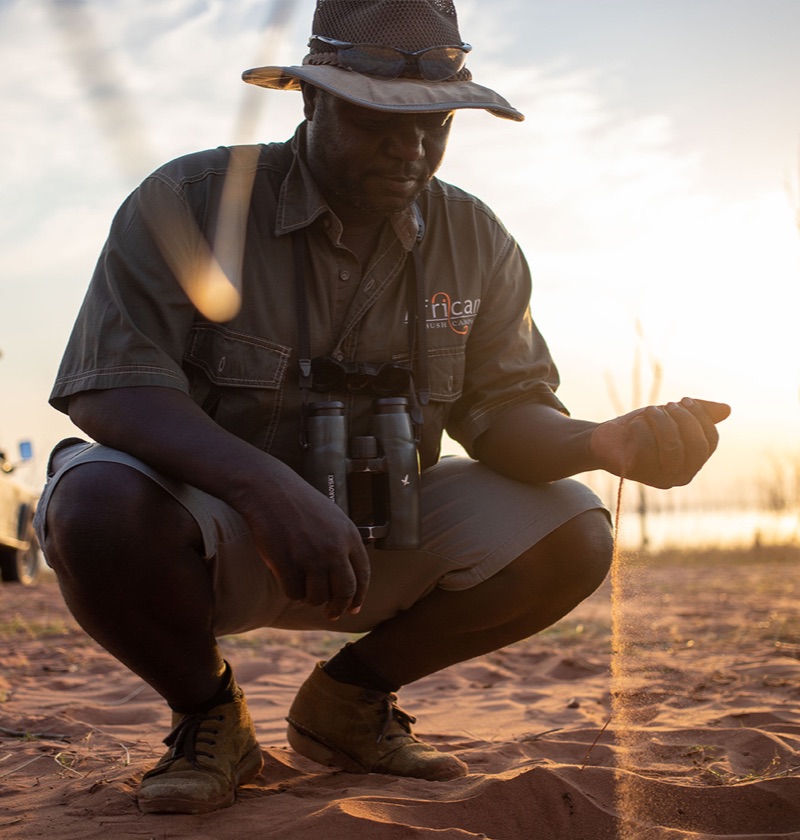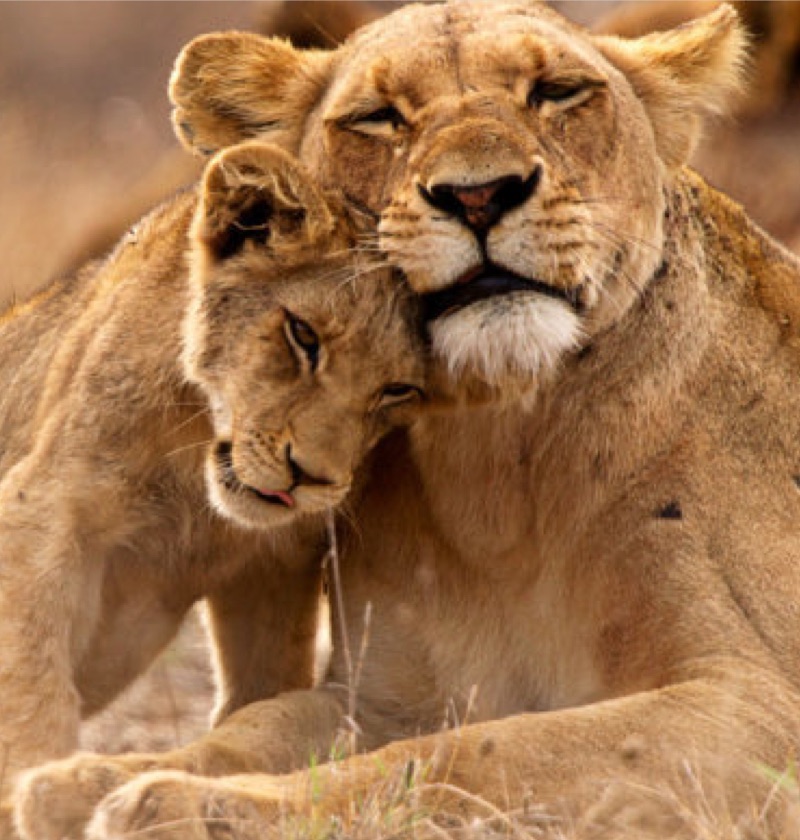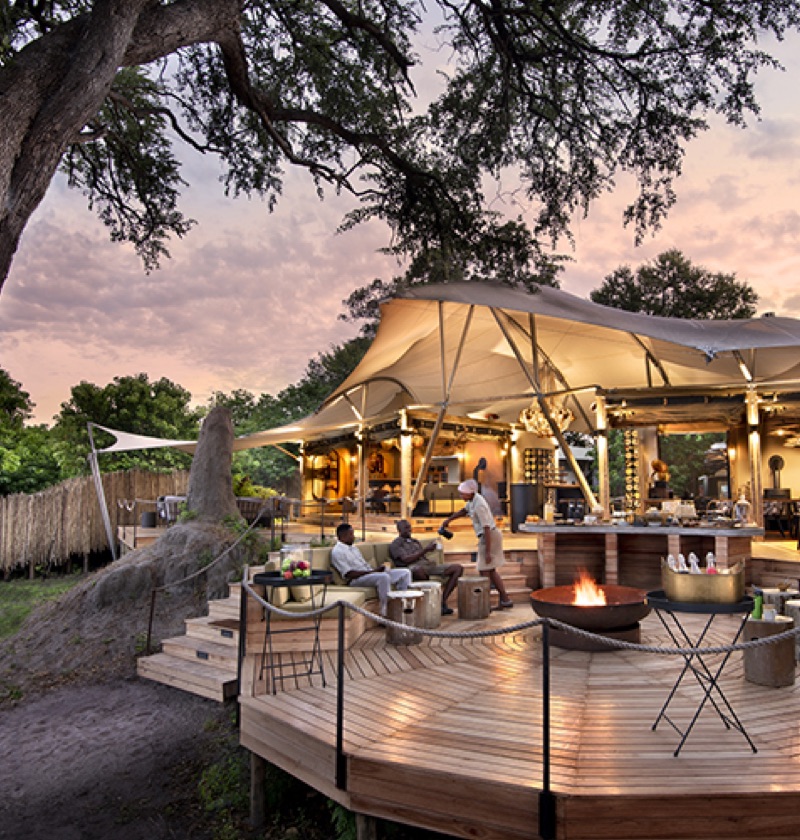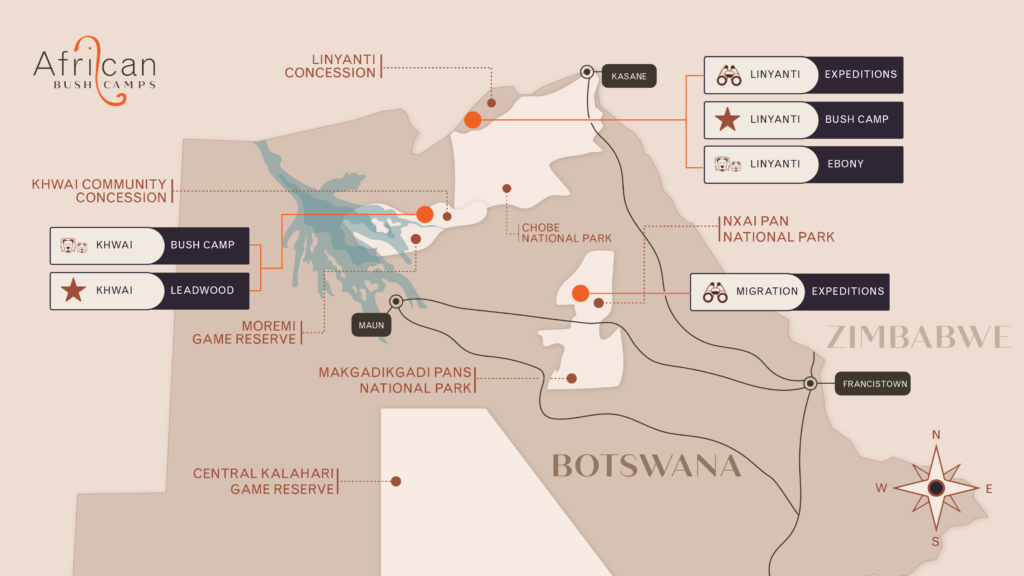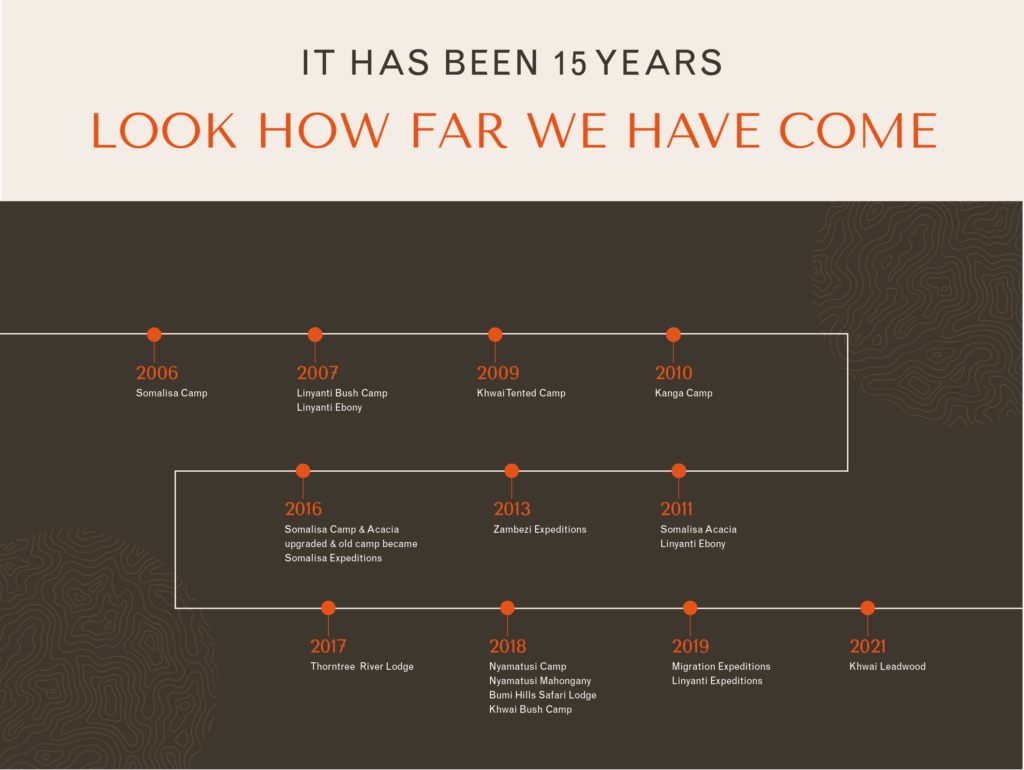My Experience of Khwai Leadwood, 2021
Traveling in 2021 made me appreciate and soak up every morsel of joy and peace I could when visiting Botswana! I wanted to learn about the land, community, wildlife and just revel in the fact that I have the privilege to be there! So, I’d like to share all that I could gather with the help of the real experts, the guides and hosts on the ground, as well as Beks himself. Travel in 2021 does have its roadblocks that slow down the logistics, but once you make it to the pristine wilderness, you’re unburdened by large crowds and feel a new sense of liberation from the stress the last months have given us.
History & Geography of Khwai Community Area
When Moremi became a Game Reserve, many displaced people moved to the Khwai Concession on the border of Moremi. The Khwai Concession was then passed on by the Botswana government to the community to own, manage and run. You can feel the conservation element within the community as there is a sense of pride in the land and the protection of its animals, which brings much-needed revenue through eco-tourism to the area. Khwai is one of the few concessions open to the public and has cheaper fees than Moremi.
All our camps lie in the Northern parts of Botswana. The areas between Linyanti, Khwai & Nxai Pan aren’t fenced, the longest migration in Africa takes place passing these areas. The zebras start from Linyanti wetlands and move past the edges of the Okavango toward the sweet grasses that the Nxai Pan brings with the rainy season.
Okavango Delta and its impact on the area
Floods & Fauna
The oddity of the water in the Khwai Area and, in essence, the Okavango Delta stems from the floods gushing from Angola. Usually, on safari you’ll have a dry season, which is the best time to see animals because there is little water, the bush is thin and animals congregate around water. But in Khwai your safari experience is a flood in the dry season. This means the typical safari seasons don’t always relate to Botswana and, in particular, Khwai because of this phenomenon. However, there is still a fantastic opportunity for wildlife, and we saw almost everything (jump here for my sighting report). Predators in this area are abundant because of the availability of food. The nutrients of the Kalahari soil that blows over combined with the bountiful amount of water makes for good vegetation. The surroundings, being rich Mopani woodland means you will find an abundance of great plains animals, which attracts many predators.
View this post on Instagram
Even though it is winter, please remember it is still a desert. The days are hot in the winter. You can expect temperatures of up to 28 degrees on some days! So don’t pack like me and only bring warm clothing (rookie error). Having said that, warm clothes are ideal for the chilly morning and evenings around the fire and on the game drives.
Geography & Topography
Banda, our guide, at one stage, took out a map to share his knowledge of the topography of Botswana and specifically the Okavango Delta. At the neck of the Delta, the tectonic plates have shifted. Some micro-tremors happen quite often in the country, but because the country is mostly made of sand, it absorbs the impact and is not noticeable to its inhabitants. The tectonic plates form part of the African Rift Valley and created two rifts, namely the Gamare Fault and the Thamalakane Fault, making this area much lower than the rest of the Botswana landscape and trapping the water in some 15 thousand square kilometres, making it the largest inland delta in the world. Botswana is a largely flat country, and these fault lines have created a basin for the floods to pool.
ABC’s History with Khwai Community Area
Khwai was the third offering we had under the ABC umbrella, but it looked a little different back then. First, Somalisa started in 2006, but Zimbabwe wasn’t the ‘flavour of the month’ at the time, so Linyanti was our second camp. The bug bit Beks and he soon felt the need to offer a “journey.” Initially, Khwai was the first mobile safari experience. Beks’ relationship with the community awarded him the ability to provide trips more than six days at a time, eventually building up to 3/4 week, with the summer route in Nxai Pan & the winter in Khwai.
Khwai soon became a guest favourite which was the start of thinking about a permanent camp.
Here is the 15-year timeline:
The Community
The community is small, only consisting of about 500 people. When we begin building any camp, the labour from the community starts the adoption process of hiring enthusiastic team members and upskilling from there. Botswana’s very famous for its basketwork, so this is incorporated in the interior of the main areas; chandeliers, cabinets, and bedrooms above the bedframes were made locally. Design elements include ‘Kgotla’ – outstanding timber with a rendering on the side, resembling a mud hut using recycled wine bottles, inspired by the builds in the area.
Our Incredible Guide – Banda
View this post on Instagram
Banda is such a good photographer, and if you just bought your camera for your once-in-a-lifetime safari, he is a great teacher on how to use your equipment and what are the top safari shots to get. He knows what pics people want to go home with, what shutter speed and exposure to choose, and where to angle the vehicle to get your perfect shot! His understated yet cheeky sense of humour will keep your safari interesting and at ease. He has incredible tracking skills, showing us that the bird sounds tell us that there may be a predator in the area. He also taught us that a particular butterfly feeds off a predator’s scat and would showcase a predator in the area. Every morning he read the ‘morning paper’ on the sandy road, looking for any sign of wildlife; footprints, slitherings or scat. One morning we tracked an elusive lion named’ grumpy’, Banda would get out and feel the sand – the lion was swimming through the water, so he was there only moments before us. He managed to stay out of our sights, but the thrill of the chase was still exhilarating.
Our Best Sightings of the Trip
Day one
On day one, we saw almost everything, which made things interesting and slightly more challenging for Banda to keep us impressed. We saw an abundance of elephants roaming around, primarily males, as the females tend to hide in the thicket to protect their young. The males tend to be calmer around vehicles, while females can be pretty defensive, especially when it comes to their babies. Later on, we did see some herds and we kept our fair distance. I appreciated the respect of their space, as we are just visitors.
Banda took us straight to the wild dog den, and we gawked and “aaawed” when trying to count all the tiny babies in the pack. There were three adults and eight pups, although we could only count seven. This first visit was the beginning of an unfortunate story that followed this pack during our stay. The unfortunate but real story of survival, especially for these endangered animals. We kept coming back to visit and watch them play and chat with each other, but the next day we only saw two adults and five pups. We thought it might be that the other pups were in a burrow, but one of the two adults returned with food, and they would have all been out to get their fill. We speculated, along with Banda’s expertise, that the hyenas might have breached the location of their den and attacked, a normal thing amongst predators. One interesting fact I learned about wild dogs is that they have a separate ‘pouch’ they can open and close as they feed on the hunt. They fill themselves while hunting and then open this pouch to store food for their young and other pack members, which they regurgitate for the young to feed, not infecting the meat with any stomach acid.
View this post on Instagram
That same night we saw three lions roaming in the area, one mother and two young males, growing in their prepubescent manes. We also spotted a serval and found that there had been a recent pattern of fewer leopards in the area. As the lion population rose, so the leopard population decreased, and in turn, the servals were out and about and thriving. In our three days, we had four or five sightings of serval. Unfortunately for Banda, this was the only thing left on our list, so the hunger was rising for a leopard sighting.
Day two
As you have to in Botswana, we did a Mokoro excursion, seeing elephants, buffalo, and waterbuck; it’s always an added interest to see them at a different angle, a slightly more vulnerable and wild one. On our walking safari, we saw and followed a group of giraffes – fun fact giraffes are the only animal that’s collective noun changes as they’re moving. They are a ‘tower’ if they’re standing still and a ‘journey’ if running together. On walking safaris, you spend much of your time inspecting dung; you do learn a lot though! Banda told us elephants are bad digestors, and when driving, they have to avoid elephant dung because they tend to eat acacia trees and thorns, which can cause a flat tire. Also, because they don’t digest much, the community members make teas out of the dung for stomach cramps (there’s even an elephant dung gin out there!). Banda took us to a water pool that had been diminishing day by day, and we parked to find the most fantastic birder’s paradise, a scurry and movement of birds having a buffet of catfish. Pelicans, spoonbill storks, knob-billed ducks. I could go on and on, but we were sitting with the son of an ornithologist and an avid American birder, so I’ll go with those. It was a sight of both frantic enthusiasm and serene stillness. We sat for a while just in awe of this unique scenery.
During the evening game drive, we were able to see the hyena den where there were so many hyena cubs of varying ages. They are curious and naughty. They would little by little grow in confidence to come towards the car, and once they did, they would walk underneath the vehicle and bump their heads on the bottom, Banda had to start the car now and then, so they didn’t chew at his cables under the vehicle. They would get the fright of their lives and would take off back to mom, and build up their confidence again to come closer. One even got enough confidence to put his paws up on the car to check us out.
On our way back to camp we were discussing the digestion of animals and I was saying that zebras digest with gas and that’s why they fart when they run away. The American couple was entertained by this, one of them had seen it but it was the other’s first time in Africa so Banda set off to try to prove this. Driving back we saw our opportunity with some zebra that we encountered. They stopped and Banda put off the headlights as they took off in a gust of loud comical fart sounds and we all packed up laughing.
Day three
On our last day, we were itching to see the leopard. We packed our bags, set them on our vehicle, and on our leopard spotting adventure, we went (pun intended). We saw an endless array of plains animals; lechwe, springbok, and zebra. We saw two adolescent zebras fighting, very interesting to see and gave us a little laugh to start the morning. We suddenly saw the plains animals had scattered, which was a sign that there might be predators in the area. We then spotted a cuddle puddle of wild dogs, cuddling tightly in the ice-cold dawn before the sun was about to rise. We couldn’t even count them properly because one of the heads was utterly submerged, and they reminded me of my dog back home (Puku). The social dynamics of wild dogs are incredible and I have a soft spot for them in my heart.
We carried on driving when Banda called for a backup vehicle as he heard something funny, so Joe, another guide, drove one to us. Now we had two sharp-eyed guides on the lookout for the leopard. And it worked, Joe found the leopard, and all of our eyes were peeled, trying to be the first in our car to spot it. Kathy, in our group, spotted this leopard, very camouflaged in the distance (clearly with very sharp eyes, she’s a birder, so that’s likely where she gets it from). Senses were heightened and the adrenaline was pumping, but Banda edged forward tactically without haste, to not scare the leopard away and get him to become a little less shy. Which meant we had more time with him. We continued slowly as the leopard walked toward a mound to feel slightly more secure with us around and posed for some epic shots. We followed him for a bit until he disappeared into the distance and we all silently thanked him for showing himself. We had got our leopard sighting, and we were content.
Khwai Leadwood smaller details & luxuries on safari
There are a few things that make sense as luxuries when you are actually on an African Bush safari, but I’ll put it here just in case:
- There’s a bar fridge in the room, offering ice-cold beverages in the hot midday.
- The food is incredible and well paired with the warm and cool temperatures.
- There is a permanent hippo visitor, a young male hippo that suns himself right in front of the deck and adds to your experience.
- The team is tight and friendly and with almost every meal you get serenaded by Khwai’s traditional songs and melodies. Everyone makes you feel more part of the family!
- Provided in the rooms are all kinds of charging cables and plugs, which is a bonus!
- Every evening when you climb into bed, your hot water bottle greets you and when you can’t bear the cold morning air you realise that another hot water bottle made it to your seat for the morning game drive. Keeping you warm and happy as you get ready to spot some wildlife.
- Botswana offers INCREDIBLE birdlife this is because of the availability of water.
- Leopards in the area have moved to Moremi because the lion population has increased – fewer leopards meaning more serval and smaller cats.
- We had Kaytee as our incredible host. He is personable & warm and it was a pleasure to get to know him. He is very good at understanding when to step in and help and when to hang back. He’s an intelligent guy with great conversation skills around the morning & evening fire.
Covid Testing
- In Botswana, we have the option to get a helicopter to fly in and conduct a Covid test the day before you leave so that you don’t have to overnight in main cities before departure.
- Botswana conducts a nose & throat swab.
- They adhere to strict times as they fly to a few camps.
Sustainability
- This beautiful camp is situated on a water table overlooking the permanent Khwai River, which is a tributary from the Okavango Delta. This means we have to conduct our business in a sustainable way so as to not impact the fragile ecosystem.
- When we use the water, the waste-management system that we pump back into the rivers is non-toxic. There are no chemicals or toxic materials used in the process.
- The water we pump out of the bio rock system is as good as drinking water (greywater) and can be pumped back into the river without issue.
- There is a large solar farm on the roof of the staff village that powers the camp.


